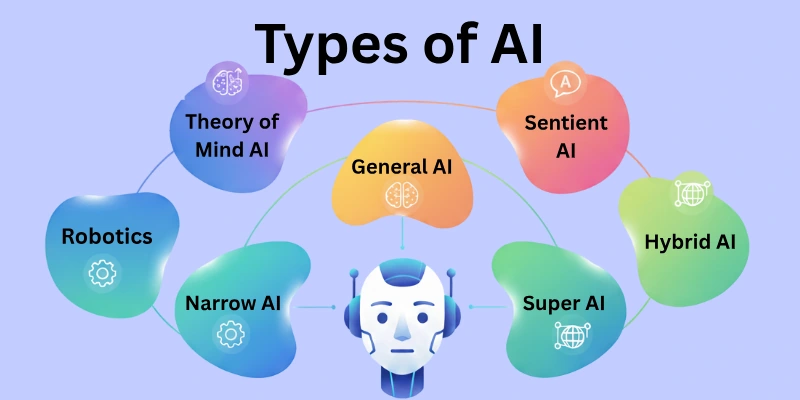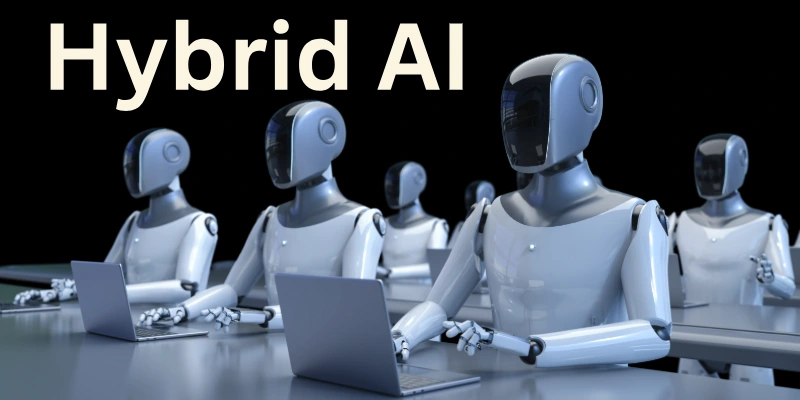Types of Artificial Intelligence: ANI, AGI, ASI
Published: 20 Aug 2025
Artificial Intelligence, or AI, is like a toolbox filled with different tools. These tools help computers do smart things. When we say “types of AI”, we’re talking about the different kinds of tools in this toolbox.
Some tools are good at specific jobs, like sorting pictures or talking to you on your phone. Others are like super-smart tools that can learn and figure out new things all on their own.

This journey through the different types of artificial intelligence systems is like opening the toolbox and seeing all the cool gadgets inside.
We’ll look at each tool and see what it’s good at, how it works, and why it’s essential in our tech world.
Why is AI Important?
Artificial Intelligence (AI) is important for a variety of reasons, and its significance spans across numerous domains. Here are several key reasons why AI is considered important:
- Automation and Efficiency: AI automates tasks, improving efficiency and reducing errors in industries like manufacturing and healthcare.
- Problem Solving and Decision Making: AI processes large datasets quickly, aiding in complex problem-solving and facilitating faster, more accurate decision-making.
- Personalization and User Experience: AI-driven recommendation systems personalize content in fields like e-commerce, enhancing user satisfaction.
- Innovation and Research: AI accelerates scientific and technological advancements, aiding research in medicine, astronomy, and other fields.
- Natural Language Processing and Communication: AI lets robots understand and use human language, which makes it easier for chatbots and virtual assistants to talk to each other.
- Enhanced Learning and Adaptability: AI systems can learn from data with the help of machine learning. They can adapt to changes and keep getting better.
- Addressing Complex Challenges: AI helps tackle complex issues such as climate modeling, cybersecurity, and urban planning by processing large datasets and identifying patterns.
Types of Artificial Intelligence
Let’s come to the main part of the article, which is about artificial intelligence types. Let me tell you that AI types are categorized into three different parts: capabilities, behaviour, and other general types.
So, here I have come up with all different types of AI.
AI Types Based on Capabilities
- Artificial Narrow Intelligence (ANI) – Weak
- Artificial General Intelligence (AGI)
- Artificial Super Intelligence (ASI) – Strong
- Machine Learning
- Deep Learning
AI Types Based on Behaviour
- Reactive Machines
- Limited Memory Machines
- Theory of Mind AI
- Self-Aware AI
Other AI Types
- Natural Language Processing (NLP)
- Computer Vision
- Robotics
- Expert Systems
- Swarm Intelligence
- Sentient AI
- Embodied AI
- Hybrid AI
- Augmented Intelligence (AI working alongside human intelligence)
- Explainable AI (XAI)
- Evolutionary Algorithms
Let’s learn about each Ai type.
AI Types Based on Capabilities
AI is categorized based on capabilities to reflect the range of intelligence levels exhibited by artificial systems. This categorization helps us understand the extent to which AI systems can perform tasks and solve problems.
The types include:
1. Artificial Narrow Intelligence (ANI)
AI systems built for a specific task or a limited set of tasks are referred to as ANI. They thrive on a certain topic but lack the overall cognitive capacities of humans.
Working: ANI is programmed to perform a specialized function and operates within well-defined parameters. It relies on pre-set algorithms to execute tasks efficiently.
Example: Virtual personal assistants like Siri or Alexa, which excel in specific voice recognition and response tasks but lack a general understanding of the world.
2. Artificial General Intelligence (AGI)
AGI aims for machines with human-like cognitive abilities, capable of understanding, learning, and adapting across a wide range of tasks similar to a human.
Working: AGI systems can comprehend, acquire, and apply information in a variety of circumstances. They can execute general intelligence activities and adjust to new settings.
Example: While AGI is a theoretical concept, it could be akin to machines possessing human-like reasoning and problem-solving abilities across diverse domains.
3. Artificial Super Intelligence (ASI)
ASI represents a level of intelligence surpassing human capabilities across every conceivable domain. It implies machines that can outperform the best human minds in virtually every field.
Working: ASI would have cognitive abilities far beyond human capacity, enabling it to excel in intellectual tasks, decision-making, and problem-solving to an unprecedented degree.
Example: ASI is currently theoretical and speculative, with no real-world examples as it surpasses human intelligence comprehensively.
4. Machine Learning
Machine Learning (ML) is a subset of AI that allows computers to learn and improve without being explicitly programmed. It focuses on the creation of algorithms that allow robots to recognize patterns and make judgements.
Working: ML algorithms process data, identify patterns, and adjust their models to make predictions or decisions. This iterative learning process allows machines to improve over time.
Example: Spam email filters that learn to differentiate between spam and non-spam emails based on user interactions.
5. Deep Learning
Deep learning is a subset of machine learning that employs multiple-layer neural networks (deep neural networks). It resembles the organization of the human brain, allowing the system to learn and make judgements.
Working: Deep learning algorithms process data through multiple layers of neural networks, extracting hierarchical features for better understanding and decision-making.
Example: Image recognition systems that use deep learning to identify objects or faces in photos.
AI Types Based on Behaviour
The categorization of AI based on behaviour helps us understand how artificial intelligence systems interact with and respond to their environment. It sheds light on the different ways AI systems exhibit intelligence and behave in various situations. The types include:
1. Reactive Machines
Reactive Machines are AI systems that are programmed to execute specific tasks. They are incapable of learning from experience or adapting to new situations.

Working: These machines follow predetermined instructions and provide responses based on fixed algorithms, without the capacity for learning or evolving.
Example: Chess-playing programs that use pre-defined strategies to make moves but don’t learn or adapt during gameplay.
2. Limited Memory Machines
Limited Memory AI systems can learn from historical data to some extent. They use past experiences to make informed decisions, but their memory is constrained compared to more advanced learning systems.
Working: These systems store and retrieve past information to improve decision-making, but they don’t have a comprehensive understanding of the entire dataset.
Example: Autonomous vehicles that use historical data to anticipate and react to traffic patterns but don’t continuously learn during each drive.
3. Theory of Mind AI
Theory of Mind refers to artificial intelligence systems that can grasp human emotions, beliefs, and intentions, allowing them to engage with people on a more empathic and socially conscious level.
Working: These systems model and interpret human emotions and behaviours, enabling more nuanced and context-aware interactions.
Example: Virtual assistants capable of recognizing and responding to users’ emotional states, adapting their tone and responses accordingly.
4. Self-Aware AI
Self-aware AI systems possess consciousness and a sense of self. They can understand their own existence, learn from experiences, and exhibit a level of introspection.
Working: These systems have the ability to reflect on their own state, make autonomous decisions, and adapt their behaviour based on self-awareness.
Example: Currently, self-aware AI is a theoretical concept, and there are no real-world examples as it extends beyond the current capabilities of AI.
Other AI Types
The categorization of AI into specific types based on functionality helps us understand the diverse applications and capabilities of artificial intelligence. Each type addresses different aspects of human cognition and problem-solving. Here are explanations for each type:
1. Natural Language Processing (NLP)
NLP refers to AI systems’ ability to perceive, interpret, and generate human language, allowing computers and humans to interact using natural language.
Working: NLP algorithms analyze linguistic patterns, semantics, and context to comprehend and respond to human language, enabling applications like chatbots and language translation.
Example: Virtual assistants like Siri or chatbots that understand and respond to spoken or written language.
2. Computer Vision
Machines can analyze and make decisions based on visual input thanks to computer vision. Image and video analysis, pattern recognition, and object detection are all part of it.
Working: Computer Vision algorithms process visual information, identifying objects, recognizing faces, and extracting meaningful insights from images or videos.
Example: Facial recognition systems, self-driving car perception, and image classification applications.
3. Robotics
Robotics involves the integration of AI with mechanical systems to create autonomous or semi-autonomous machines capable of performing physical tasks.

Working: AI algorithms in robotics allow machines to sense their surroundings, make decisions, and carry out physical activities, paving the way for applications in industry, healthcare, and exploration.
Example: Industrial robots assembling products, surgical robots assisting in medical procedures.
4. Expert Systems
Expert Systems are artificial intelligence (AI) programmes that are designed to mimic the decision-making abilities of a human expert in a certain topic.
Working: These systems use knowledge bases and rule-based reasoning to analyze information and provide solutions or recommendations within a particular field.
Example: Diagnostic systems in healthcare, providing expert-like advice based on symptoms and medical knowledge.
5. Swarm Intelligence
Swarm intelligence is the collective behaviour of decentralised, self-organized systems, which is typically inspired by the behaviour of social insects.
Working: AI algorithms simulate interactions among agents to achieve collective intelligence, useful in optimization problems and decentralized decision-making.
Example: Swarm robotics for tasks like exploration, environmental monitoring, or disaster response.
6. Sentient AI
Sentient AI refers to systems with self-awareness and consciousness, aiming to mimic human-like cognitive capabilities.
Working: Currently more theoretical, sentient AI would involve machines that possess subjective experiences and self-awareness.
Example: Sentient AI remains a speculative concept without real-world examples at present.
7. Embodied AI
Embodied AI involves machines with physical bodies or avatars, allowing them to interact with the environment.
Working: AI systems integrate sensory information from the physical world to make decisions and adapt to their surroundings.
Example: Social robots capable of physical interactions or AI-driven avatars in virtual environments.
8. Hybrid AI
Hybrid AI combines different AI technologies, such as machine learning and rule-based systems, to leverage the strengths of each approach.

Working: Integrating multiple AI techniques enhances performance and flexibility, allowing systems to handle diverse tasks effectively.
Example: Combining rule-based reasoning with machine learning for a medical diagnosis system.
9. Augmented Intelligence (AI Working alongside Human Intelligence)
Augmented Intelligence focuses on AI systems complementing human abilities, enhancing decision-making and problem-solving.
Working: AI assists humans by providing insights, automating repetitive tasks, and improving overall performance.
Example: Smart assistants, like AI-powered suggestion tools, aiding professionals in decision-making.
10. Explainable AI (XAI)
Explainable AI emphasizes the transparency and interpretability of AI systems, allowing users to understand how decisions are made.
Working: XAI provides clear explanations of AI models, making it easier for users to trust and comprehend the reasoning behind AI-driven decisions.
Example: Machine learning models with easily interpretable features and decision-making processes.
11. Evolutionary Algorithms
Evolutionary Algorithms use principles inspired by biological evolution to optimize solutions for complex problems.
Working: These algorithms involve populations of solutions evolving over generations through processes like selection, mutation, and crossover.
Example: Genetic algorithms for optimizing solutions in fields like engineering and finance.
Conclusion
So, my dear ones, in this article, we have discussed artificial intelligence types in great detail. We divided AI into three levels and then explored further types, delving into the definition, working, and examples of each.
I would like to add here that AI has truly transformed this world, constantly updating itself with each passing day. I hope a significant revolution is on the horizon. So, it’s better to embrace AI and shape our future within its world.
FAQs
Here are some of the most commonly asked questions related to Types of AI:
AI, or Artificial Intelligence, is the ability of machines to perform tasks that normally require human intelligence. It can learn from data, solve problems, and make decisions. AI is used in many fields like healthcare, education, business, and daily life. Examples include chatbots, self-driving cars, and virtual assistants.
AI learns from data and follows patterns given to it by humans. It is fast, accurate, and can handle large amounts of information. However, AI cannot truly feel emotions or think creatively like humans. Human intelligence is flexible, emotional, and based on real-world experience.
Weak AI, also known as narrow AI, is designed for a specific task and lacks general cognitive abilities. Strong AI, on the other hand, possesses human-like cognitive abilities and understanding and can perform tasks across a wide range of domains.
Here are the three main types of AI mentioned:
- Narrow AI: Weak AI focused on specific tasks (e.g., facial recognition).
- General AI: Strong AI, if it existed, would have general intelligence like humans.
- Superintelligence: Hypothetical level surpassing human intelligence in all aspects.
AI names:
- Personal assistants: Siri, Alexa, Google Assistant.
- Language models: BERT, GPT-4, Gemini.
- Robotics systems: Pepper, Atlas, Roomba.
Here is the list of some of the most well-known artificial intelligence tools:
- Image recognition: Google Lens, Amazon Rekognition.
- Machine translation: Google Translate, DeepL.
- Predictive analytics: Salesforce Einstein, Amazon Forecast.
- Robotic process automation: UiPath, Blue Prism.
- Content creation: Jasper, ShortlyAI.
- Customer service bots: Drift, HubSpot.
- Fraud detection: Featurespace, FICO Falcon.
Yes, AI is significantly impacting and will continue to transform diverse fields like healthcare, transportation, and entertainment. Both positive and negative effects are expected, requiring careful ethical considerations and responsible development.

- Be Respectful
- Stay Relevant
- Stay Positive
- True Feedback
- Encourage Discussion
- Avoid Spamming
- No Fake News
- Don't Copy-Paste
- No Personal Attacks

- Be Respectful
- Stay Relevant
- Stay Positive
- True Feedback
- Encourage Discussion
- Avoid Spamming
- No Fake News
- Don't Copy-Paste
- No Personal Attacks





